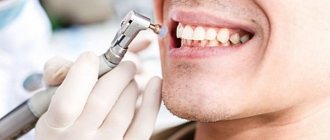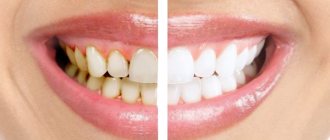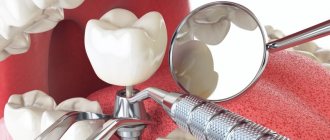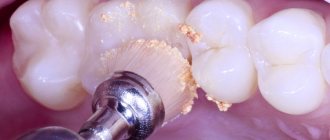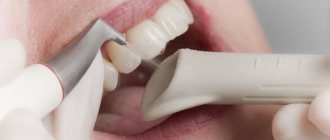Tartar not only disrupts the aesthetics of a smile, but leads to gum disease, bad breath, the development of dental caries and, in advanced cases, tooth loss.
Regular teeth cleaning using ultrasound removes hard plaque from the surface of the teeth and from shallow periodontal pockets (maximum up to 5 mm), the procedure is carried out using a special device - a dental scaler (scaler). The device can be built into a dental unit or stand-alone.
An ultrasonic scaler consists of a control unit and vibration generation unit, a handpiece, removable (replaceable) attachments and a control pedal. The device is equipped with a liquid supply system. During operation, the device creates ultrasonic vibrations with a frequency of 25-30 kHz, which are transmitted to the tip nozzle.
Physical principle of operation: an ultrasonic wave is transmitted from the tip to the scaler nozzle, which in turn transfers it to dental plaque. Under its influence, deposits are destroyed from the inside. To prevent damage to tooth enamel, the dentist moves the attachment strictly along the surface of the tooth. The simultaneous supply of water to the zone of ultrasound influence provokes the effect of cavitation, the formation of micro-bubbles in the volume, which accelerate the process of destruction of tartar. At the same time, water or a medicinal solution helps wash away dental plaque destroyed by ultrasound from the treatment area.
Benefits of ultrasonic teeth cleaning
The first devices for ultrasonic teeth cleaning, which appeared in the 60s of the last century, were somewhat imperfect, and after their use, damage to the enamel could occur. Therefore, plaque and tartar were often cleaned manually. Modern ultrasonic units are absolutely safe; they are used not only for removing tartar, but also for removing crowns, minimally invasive preparation of enamel areas affected by caries, and caring for dental implants.
The benefits of ultrasonic teeth cleaning include:
- Painless;
- Safe and complete removal of plaque in small periodontal pockets and on the surface of teeth;
- Impact exclusively on problem areas;
- The ability to regulate the strength of ultrasound;
- A variety of tips designed to work on different areas of the tooth surface;
- High hygiene of the procedure;
- Automatic adjustment of the system to the load;
- A quick and easy procedure that can be performed by a hygienist. Complex cases with deep periodontal pockets are not considered here;
- Affordable price.
Advantages of the method
If you listen to the opinions of experienced dentists and collect all the reviews about ultrasonic teeth cleaning from those people who have had it performed, you can highlight the following advantages of the technique:
- High efficiency. Ultrasound is very good at removing both soft plaque and tartar, which can be very difficult to remove with other methods.
- Painless. In most cases, ultrasonic cleaning does not hurt. If the patient has increased sensitivity of the enamel or has subgingival dental deposits, then slight discomfort is possible. In order to eliminate it, local anesthesia is used, so the patient does not experience any discomfort.
- Execution speed. The duration of the procedure is about 30 minutes, in rare cases it can last for one hour. As a result, the patient can rationally plan his day and visit the dentist at any convenient time, even during lunch break.
- Cleaning and bleaching. If you compare the photos before and after ultrasonic teeth cleaning, you will notice that the enamel has become a little whiter. The whitening effect is very light - only 1-2 tones, but do not forget that the main purpose of the method is to eliminate dental plaque. And whitening will be a pleasant plus, without the need to use chemicals and waste extra time.
- Affordable price. Ultrasonic teeth cleaning in Moscow is performed in many clinics, which charge different prices for this service. Institutions constantly hold promotions and discounts for their clients, which will allow them to save some money.
- Minimum list of contraindications. The procedure is not recommended for patients with dental implants, braces and other orthodontic devices, for children with baby teeth, etc.
Thanks to the advantages described above, ultrasonic teeth cleaning is a very popular and in demand procedure. It does not have a negative effect on the teeth and at the same time allows you to effectively clean hard-to-reach places, thereby maintaining the oral cavity properly clean.
Indications for use
Almost every adult needs ultrasonic teeth cleaning to prevent the formation of dental plaque, but there are categories that are recommended to perform the procedure first:
- Patients preparing for caries treatment and teeth whitening, installation of implants, braces, dentures;
- Patients after removal of braces;
- Patients with installed implants, crowns (special plastic attachments are used for cleaning);
- Patients diagnosed with gingivitis or periodontitis.
Contraindications
Like any medical procedure, ultrasonic teeth cleaning has its contraindications:
- Installed pacemaker;
- Acute inflammatory processes in the periodontium, osteomyelitis;
- Oncological neoplasms in the oral cavity;
- Erosion of soft and hard tissues of the oral cavity;
- Severe form of diabetes mellitus;
- Acute and chronic infectious diseases;
- Severe diseases of the cardiovascular system;
- Epilepsy;
- A history of retinal surgery (consultation with an ophthalmologist is required).
Main contraindications
When visiting our dentistry, the patient must undergo a full examination of the oral cavity. If the following cases are detected, treatment is prescribed or the doctor refuses the service:
- for diseases of soft tissues (gums) and the presence of caries, treatment is first performed;
- Lightening should not be carried out in case of AIDS, tuberculosis and sarcoma;
- if the enamel is severely damaged and has a large number of microcracks;
- with allergic reactions to drugs;
- during breastfeeding and pregnancy;
- there are age restrictions up to 18 years;
- with braces, crowns and veneers.
Ultrasonic whitening is an effective and quick way to get a dazzling smile, but in any case, experts advise periodic examinations in the dental office. This approach to health will always allow you to be confident in your teeth and, if necessary, eliminate defects in the early stages, which will ultimately affect minimal costs.
Methodology
Assuming that the medical history has been collected and the patient has been given all the necessary explanations, ultrasonic teeth cleaning is carried out in the following sequence:
- The patient sits in a chair, the doctor examines the oral cavity and determines the amount of work to be done. In case of increased tooth sensitivity, local anesthesia is performed, but usually the procedure is carried out without additional anesthesia;
- The doctor installs a mouth opener - a special device that helps the patient hold his mouth open for a long time (the cleaning procedure lasts about 30 minutes on average). Thanks to the mouth retractor, the dentist gets full and unobstructed access to the surface of the teeth;
- Dental plaque is removed with an ultrasonic scaler. The water that is supplied to the tooth surface during operation of the device, along with particles of tartar and saliva, is removed from the oral cavity using a saliva ejector. First, the visible part of the crowns is cleaned of soft deposits, then tartar along the gum border is removed, and finally, periodontal pockets are curetted;
- Upon completion of the plaque removal procedure, the doctor polishes the surface of the teeth with a special polishing paste, this makes the enamel smooth and prevents plaque from re-attaching;
- The next stage (performed if necessary) is the treatment of teeth with a fluoride-containing gel, which strengthens the enamel and restores its structure. The composition is also able to protect the enamel from external influences and reduce tooth sensitivity;
- If there is inflammation on the gums, they are treated with anti-inflammatory drugs. The patient continues to care for his gums at home using products recommended by the dentist: this can be rinsing or treating the gums with gels and solutions purchased at the pharmacy.
Methods for removing tartar
There are the following effective ways to remove hardened plaque:
- Use of hand tools. This method was especially often used during the existence of the USSR. Dentists used curettes - instruments with sharp edges that can be used to scrape off hardened formations. The modern development of dentistry has made it possible to abandon such an ineffective and traumatic method.
- Application of ultrasound.
- Cleaning teeth with a mixture of air, water and soda, supplied under high pressure through the tip of the device. This method is called sandblasting. Its essence is as follows: the smallest particles of soda, moving at very high speed, knock down deposits. This method is effective if the stones are small: large stones or subgingival deposits will be almost impossible to remove.
Comprehensive hygienic cleaning
For more effective cleaning of the dental surface, we recommend that our patients undergo comprehensive oral cleaning, which includes:
- Ultrasonic cleaning of teeth from tartar;
- Air Flow cleaning – removal of micro-roughness remaining on the enamel surface after removing tartar. Cleaning is carried out with a special abrasive mixture, which is supplied under high pressure. Also, with the help of Air Flow, pigment spots and “smoker’s plaque” are removed, the tooth surface becomes much lighter;
- Polishing the enamel surface with paste;
- Deep fluoridation of tooth enamel (if necessary).
If the patient, after comprehensive hygienic cleaning of the oral cavity, follows the rules for caring for the oral cavity, then he reduces the likelihood of re-formation of tartar, because prevents the hardening of soft dental deposits that inevitably accumulate on the surface of the teeth. Therefore, during the next preventive examination, teeth cleaning may be limited to using the Air Flow method to remove stained plaque.
For periodontal pockets deeper than 5 mm, it is recommended to undergo a procedure for removing hard deposits using a vector device.
Ultrasound or Air Flow: which is better?
A common mistake is to consider the two types of professional cleaning separately: for better results they are used in combination. Ultrasound removes complex surface contaminants, Air Flow cleans hard-to-reach areas and polishes enamel. After the procedure, it responds well to remineralization, so at the end of professional oral hygiene, the teeth are polished with a brush and coated with fluoride-containing preparations.
To maintain a healthy smile, dentists recommend professional teeth cleanings periodically - once every six months. With regular visits to the doctor and proper hygiene, deposits do not have time to harden and turn into stone. In such cases, the attending physician may suggest doing without ultrasound and limiting yourself to only the Air Flow procedure or creating an individual schedule for sanitation of the oral cavity.
Caring for your teeth after ultrasonic cleaning
After the procedure, especially if a lot of plaque has been removed, there is a slightly increased sensitivity of the teeth to temperature and chemical irritants, so for 24 hours after cleaning, patients are advised to refrain from eating excessively hot, cold, sour and salty foods. It is advisable to follow a “white diet” for a couple of days, as after teeth whitening, to exclude strongly coloring foods from the diet (red wine, coffee, black tea, beets, some bright fruits and juices from them) so that the cleaned enamel does not absorb food dyes, and on the contrary, enrich it with solid and fiber-containing products that will prevent the appearance of plaque and stones (fruits, vegetables, nuts, etc.).
If sensitivity is severe, it is recommended to replace your regular toothbrush with a soft-bristled brush for several days and purchase toothpaste that reduces sensitivity.
After each meal, you need to rinse your mouth with clean water - this rule must be observed not only after ultrasonic cleaning, but also constantly.
On the first day or two, it is also recommended to brush your teeth after every meal.
The most frequently asked questions from patients about the procedure
How painful is it?
(click to expand) Ultrasound teeth cleaning is a painless procedure, but it may be accompanied by minor discomfort in the presence of subgingival dental deposits - to remove them you need to slightly disturb the gums. Patients with increased sensitivity of the enamel may also complain of pain. In such cases, the doctor will perform cleaning with maximum comfort for the patient, using local anesthesia.
Is ultrasonic cleaning whitening? (click to expand) No, whitening is a completely different procedure, it is carried out using special whitening compounds that are applied to the tooth. A slight lightening of the enamel is due to the fact that after ultrasonic cleaning, the surface of the teeth is polished; sometimes the difference in color is clearly visible.
Is it true that plaque appears on teeth faster after ultrasonic cleaning? (click to expand) No, that's not true. On the contrary, after ultrasonic cleaning followed by polishing the enamel, plaque appears more slowly. Maintaining oral hygiene helps prevent its occurrence: responsible brushing of teeth at least 2 times a day, rinsing the mouth after meals, choosing the right toothpaste. Smoking, excessive consumption of tea and coffee, and metabolic disorders in the body contribute to the rapid appearance of plaque.
Can cleaning damage the enamel? (click to expand) If the procedure is carried out correctly, damage to tooth enamel is excluded. After cleaning, weak and thin enamel is additionally strengthened with remineralizing gels, the enamel is actively saturated with microelements, and it becomes stronger.
What should I do if I have an acute inflammatory process on my gums? (click to expand) Acute inflammation of the gums, accompanied by bleeding, in most cases is a contraindication to ultrasonic teeth cleaning until acute symptoms are relieved. We offer our patients tartar removal simultaneously with gum treatment using the Vector device. This is a specially designed ultrasonic scaler that is equipped with a unique Paro tip that creates special ultrasonic vibrations. The device allows for deeper treatment of periodontal pockets if the patient is diagnosed with periodontitis; Simultaneously with the removal of dental plaque, the enamel is polished with a special polishing liquid. After its use, supragingival and subgingival deposits, inflammation of soft tissues and bleeding are completely eliminated, bad breath disappears, and oral health is restored.
Is the procedure allowed during pregnancy? (click to expand) Ultrasonic teeth cleaning is not only allowed for pregnant women, but is also recommended for mandatory use. This is explained by the frequent occurrence of problems with teeth and gums in pregnant women due to hormonal changes and the need to sanitize the oral cavity before childbirth. The procedure is completely safe for the health of the expectant mother and her baby, but you still need to consult a gynecologist before performing it.
How often should you resort to ultrasonic teeth cleaning? (click to expand) We recommend that our patients have their teeth cleaned with ultrasound every 6-12 months; sometimes, if there is an increased tendency to form plaque, cleaning is done more often. The best solution is to carry out a comprehensive oral hygiene cleaning, which helps maintain oral health and fresh breath.
Ultrasonic teeth cleaning helps prevent the development of many dental diseases, so do not neglect this procedure.
Advantages of extraction in ultrasound dental treatment
Among the advantages of the described method for removing units that cannot be restored are:
- Low invasiveness and maximum precision. The waves do not directly contact the gums and mucous membranes, but at the same time provide high accuracy of impact in the operating area. As a result, healthy tissues remain almost untouched and are preserved in full.
- No discomfort for the patient. If we compare wave equipment with a drill (it can be used if you need to drill out the roots during surgery), then the advantage is obvious - it does not heat the bone tissue. This makes the intervention less noticeable to humans.
- High treatment speed. When using new equipment, the most difficult stage goes much faster.
- Low risk of developing postoperative complications. Waves cannot introduce infection into the wound and do not lead to inflammation of the gums and bone tissue.
Cost of ultrasonic teeth cleaning
One of the first questions that patients are interested in is how much does ultrasonic teeth cleaning cost? This procedure is one of the most affordable in dentistry, its cost depends on the individual characteristics of the body, in particular, in some people, tartar is almost completely dissolved by saliva, in some people periodontal pockets do not form, or the opposite example, in the presence of severe curvature of the teeth, Hard plaque forms so heavily that it will take an hour or more to thoroughly remove it.
In our clinic, the cost of ultrasonic teeth cleaning is fixed and unchanged. For complex cases, our clear recommendation is to use the vector device.
Prices for ultrasonic teeth cleaning in Dental World dentistry.
What does ultrasonic teeth whitening mean?
Smoking, abuse of strong coffee-containing drinks and tea are the main reasons for the appearance of hard dental deposits and dark pigment spots on the enamel.
Unfortunately, standard brushing with a toothbrush, by definition, cannot bring tangible results.
Ultrasonic whitening is usually used as an additional procedure to other types of cleaning.
This process, depending on the degree of contamination of the enamel, can last from 20 minutes. up to half an hour. This procedure is completely painless, and anesthesia may only be required in complex clinical cases.
During ultrasonic whitening, the enamel is not subjected to mechanical stress, and there is no possibility of scratches or cracks.
Immediately after the procedure is completed, the teeth will begin to “breathe” again and will be able to absorb nutrients.
